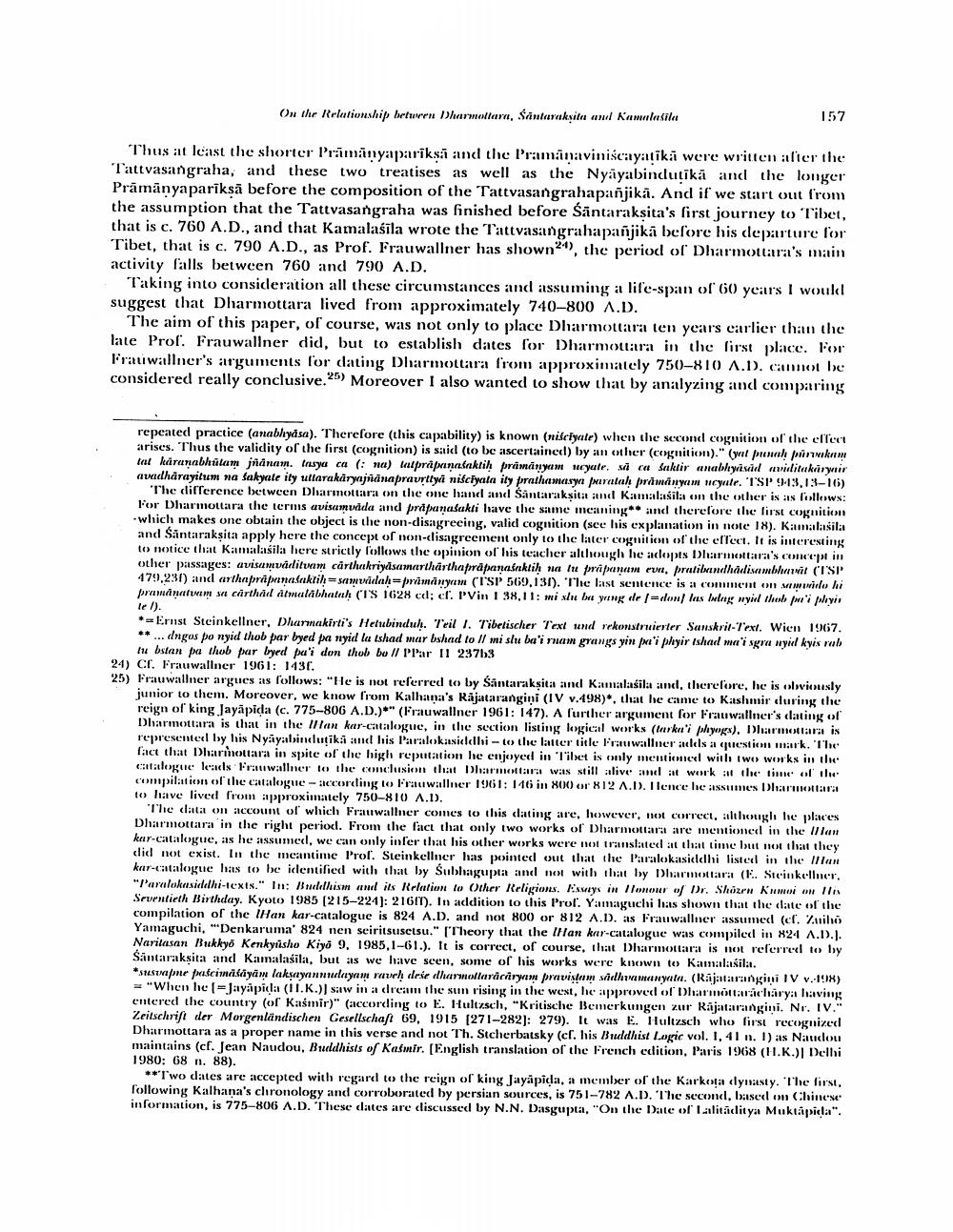Book Title: On Relationship Between Dharmottara Santaraksita And Kamalasila Author(s): Helmut Krasser Publisher: Helmut Krasser View full book textPage 7
________________ On the Rrlutionship between Dharmottarn, Santarakita anul Kawalafilu 157 Thus at least the shorter Prämányapariksa and the Pramanaviniscayatika were written aller the Tattvasangraha, and these two treatises as well as the Nyayabindutikā and the longer Prāmānyapariksā before the composition of the Tattvasangrahapanjika. And if we start out from the assumption that the Tattvasangraha was finished before Santaraksita's first journey to Tibet, that is c. 760 A.D., and that Kamalasila wrote the Tattvasangrahapanjika before his departure for Tibet, that is c. 790 A.D., as Prof. Frauwallner has shown21), the period of Dharmottara's main activity falls between 760 and 790 A.D. Taking into consideration all these circumstances and assuming a life-span of 60 years I would suggest that Dharmottara lived from approximately 740-800 A.D. The aim of this paper, of course, was not only to place Dharmottara ten year's earlier than the late Prof. Frauwallner did, but to establish dates for Dharmottara in the first place. For Frau wallner's arguments for dating Dharmottara from approximately 750-810 A.D. cannot be considered really conclusive.25) Moreover I also wanted to show that by analyzing and comparing repeated practice (anabhyasa). Therefore (this capability) is known (nifciyate) when the second cognition of the effect arises. Thus the validity of the first (cognition) is said to be ascertained) by another cognition)." (yol panah prvkam tal karanabhatam jñanam. Insya ca (: na) tatprapanasaktih pramanyam ayatr. i ca Saktir anablysád aviditukargir avadharayitrem na Sakyale ity uttarakaryajanapravrttyi niściyata ity prathamasya puratah prawnym wyle. T'SP 9-13,13-16) The difference between Dharmottara on the one hand and Santaraksita und Kamalasila on the other is as follows: Fer Dharmottara the terms avisamudda and präpanasakti have the same incaning and therefore the first cognition .which makes one obtain the object is the non-disagreeing, valid cognition (sce lis explanation in note 18). Kumalasila and Santaraksita apply here the concept of non-clisagreement only to the later cognition of the effect. It is interesting to notice that Kamalasila here strictly follows the opinion of his teacher although he adopts larmetara's Con i ll other passages: avisamvaditum carthakriydsamartharthaprapanasaktih na in pripram run, pratilindhádisambhal (IS 179,231) and arthaprapranasaktih samvidahprimanyam (TSP 569,131). The last sentence is a comment on wide hi pramanatuam sn carthad atmalabhatah (I'S 1628 cel; cf. Vin 1 38.11: wise line yang dr/don las inlng wird thol pili miyin le 1). *Ernst Steinkellner, Dharmakirti's Helubinduh. Teil 1. Tibetischer Text und rekonstruierter Sanskrit-Text. Wien 1967. ** ... dngos po nyid thob par byed pa nyid la Ishad mar bhad to Il mi slu ba'i ruam gyangsyin ili phyir ishad waisgra nyiil kyis rub the bstan pa thob par byed pa'i don thub bo // PPar 11 23753 24) Cr. Frauwallner 1961: 1431. 25) Frauwallner argues as follows: "He is not referred to by Santarakṣita and Kamalašila and, therefore, he is obviously junior to them. Moreover, we know from Kalhama's Rājatarangini (IV v.498), that he came to Kashmir during the reign of king Jayapida (c. 775-806 A.D.)*" (Frauwallner 1961: 147). A further argument for Frauwallner's dating of Dharmottara is that in the Illan kar-catalogue, in the section listing logical works (tarka'i phynx), Darmottara is representeel lwy lis Nyayalindurika and his Paralokasielelhi - to the latter title Prawallner ackes a question mark. The fact that Dharnottara in spite of the high reputation he enjoyed in "Tibet is only mentionel with two works in the catalegue levels Frauwallner to the conclusion that Dharmettara was still alive and at work at the time of the compilation of the catalogue - coreling to Frau wallner 1961: 146 in H00) er 812 1.1). Ilence he s e's Dharm to have lived from approximately 750-810 A.D). The data on account of which Frauwalhner comes to this dating are, however, not correct, although he places Dharmottara in the right period. From the fact that only two works of Dharmottara are mentioned in the Illan sue, ils he assumeel, we can only inler that his other works were not translated at that time but not that they 1. Steinkellner has pointed out that the Paralokasicldhi listed in the Illan kar-catalogue has to be identified with that by Subhagupta and not with that by Dharmotarat (E. Steinkellner. "Paralokasiddhi-texts." In: Ittehism and its Relation to Other Religions. Essays in Ilonour of Dr. Shõru Kumwan Ils Sruentieth Birthday. Kyoto 1985 (215-224): 21617). In addition to this Prol. Yamaguchi las shown that the date of the compilation of the IHan kar-catalogue is 824 A.D. and not 800 or 812 A.D. as Frauwallner assumed (cl. Z o Yamaguchi, ***Denkaruma 824 nen seiritsusetsu." [Theory that the lHan kar-catalogue was compiled in 824 A.D.). Naritasan Bukkyo Kenkyrisho Kiyo 9. 1985,1-61.). It is correct, of course, that Dharmottara is not referred to buy Santaraksita and Kamalasila, but as we have seen, some of his works were known to Kamalasila. susunane pašcimalayam laksayınlayam ravrh drie dharmollarāciryaw pravistam sdh mengata. (Rajatarangini IV v.1998) "When he jayapicla (11.K.) w in a clean the sun rising in the west, he approve of Dhanorachary Having entered the country (of Kašmir)" (according to E. Hultzsch, “Kritische Bemerkungen zur Rajatarangini. Nr. IV." Zeitschrift der Morgenländischen Gesellschaft 69,1915 (271-282): 279). It was E. Hultzsch who first recognized Dharmottara as a proper name in this verse and not Th. Stcherbatsky (cl. his Bruddhist Logic vol. I, 41 n. 1) as Naucou maintains (cf. Jean Naudou, Buddhists of Kasmir. [English translation of the French edition, Paris 1968 (H.K.) Delhi 1980: 68 n. 88). **Two dates are accepted with regard to the reign of king Jayapida, a member of the Karkea cynasty. The first. Following Kalhana's chronology and corroborated by persian sources, is 751-782 A.D. The second, 1:scel information, is 775-806 A.D. These dates are cliscussed by N.N. Dasgupta, "On the Date of Lalitaclitya Muktapicla".Page Navigation
1 ... 5 6 7 8
